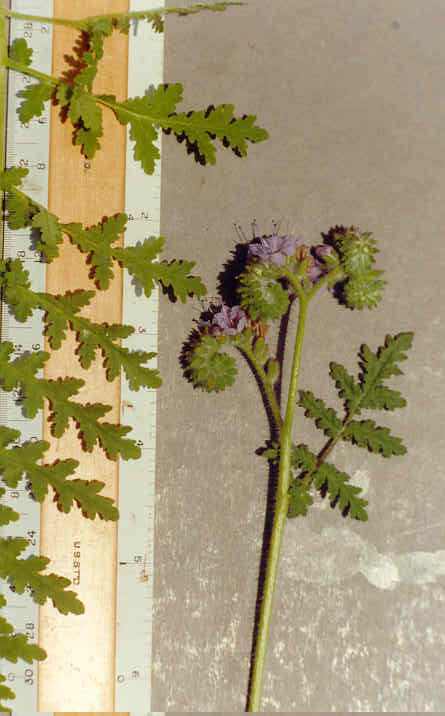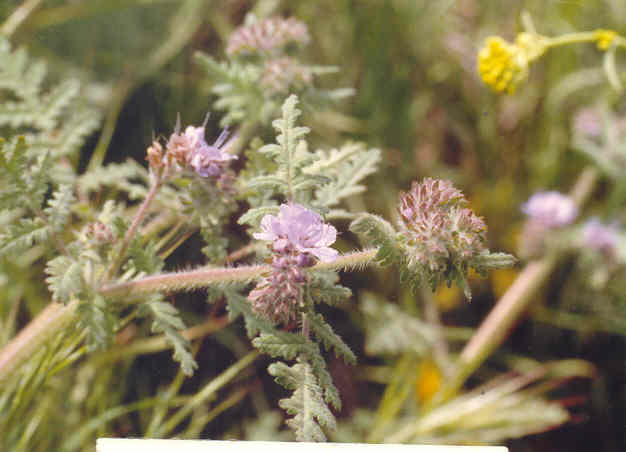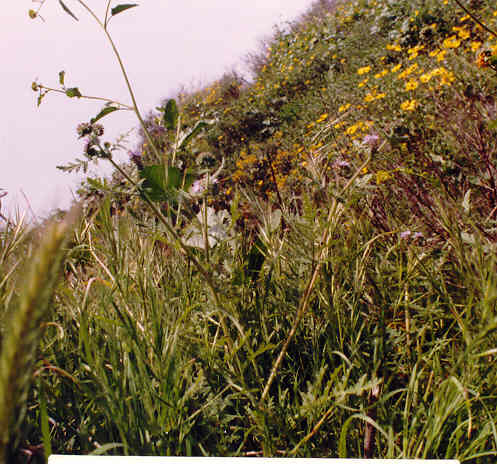
Phacelia ramosissima Lehm. var. latifolia (Torr.) Cronq. = Phacelia ramosissima var. suffrutescens
 |
Phacelia ramosissima Lehm. var. latifolia (Torr.) Cronq. = Phacelia ramosissima var. suffrutescens
HydrophyllaceaeWaterleaf FamilyNativeBranching Phacelia |
April Photo
Plant Characteristics:
Perennial, 30-150 cm. tall; stems glandular, prostrate to ascending,
many-branched, hairs mostly long, coarse, stiff, bulb-based, some hairs soft,
spreading; lf. blades 40-200 mm., generally much longer than petiole, oblong to
widely ovate, compound; lflets. +/- sessile, elliptic to oblong, coarsely
toothed or lobed, lobes often toothed; fls. +/- sessile; calyx lobes 4-6 mm.,
not generally longer in fr., oblanceolate to +/- spoon-shaped; corolla 5-8 mm.,
funnel to bell-shaped, white to lavender, scales ovate; stamens 7-10 mm.,
exserted, glabrous; style 7-10 mm., exserted; fr. 3-4 mm., ovoid, sharply
bristly; seeds 2-4, 2-3 mm., pitted.
Habitat:
Frequent in canyons below 8000 ft.; mostly Chaparral and Yellow Pine
Forests; interior s. Calif. from L. Calif. to Tehachapi Mts. and Panamint Mts.
and to Santa Clara Co. May-Aug.
(Munz, Flora So. Calif. 516).
Name:
Greek, phakelos, a cluster, because of
the crowded flowers. (Munz, Flora
So. Calif. 502). Latin, ramus, a
branch. (Jaeger 217). The
superlative degree ramosissima,
meaning most branched. (John Johnson). Latin,
latus, broad, wide.
(Jaeger 137). Latin, folium,
leafy, full of leaves. (Jaeger
104). Latifolia,
with broad or wide leaves.
General:
Occasional on the bluffs northerly of 23rd St. My specimens have a slightly
pubescent style unlike the Munz description which says it is glabrous.
This characteristic is not mentioned in Jepson. In 1995, I found a huge
plant or plants at the edge of the willows in Santa Ana Heights.
This plant measured roughly 5 meters across in one direction and 4 meters
in the other. (my comments).
The Kawaiisu, Indians of the southern Sierra Nevada gathered the stems
and leaves of P. ramosissima before the flowers appeared. They cooked these by placing them on a flat rock and then
covered them with hot rocks. More
stems and leaves were added and water was sprinkled on the hot rocks. (Campbell
139). Perhaps
200 spp. of New World, especially in w. N. Am., some of horticultural value
including the California Bluebell, Phacelia
minor. (Munz, Flora
So. Calif. 502 & Bailey 830).
Bristly hairs may cause severe dermatitis. California perennials often hybridize and are difficult to
separate. (Hickman, Ed. 691).
See P. tanacetifolia for
additional information on the genus. (my
comment).
Text Ref:
Abrams, Vol. III 493; Hickman, Ed. 705; Munz, Flora
So. Calif. 516; Roberts 27.
Photo Ref:
April-May 91 # 3,4,6; April-May 92 # 35.
Identity: by R. De Ruff,
confirmed by John Johnson.
First Found: April 1991.
Computer Ref: Plant Data 417.
Have plant specimen.
Last edit 12/26/04.
 |
 |
April Photo April Photo